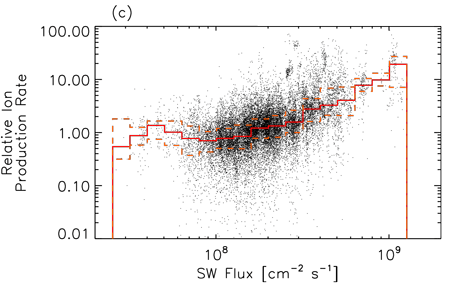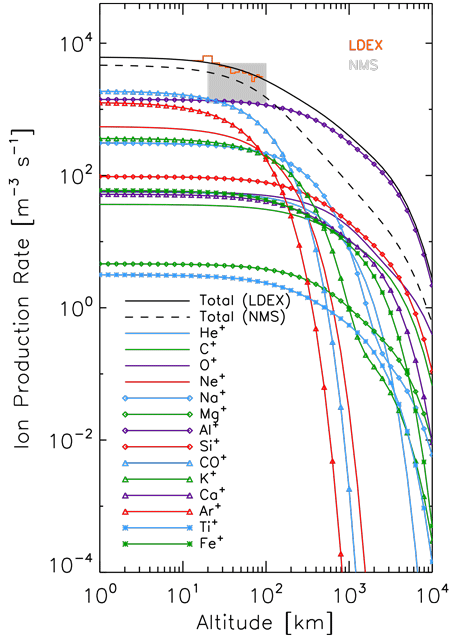2016 ARTEMIS SCIENCE NUGGETS
LADEE/LDEX and ARTEMIS observations of lunar pickup ion variability
by A. R. Poppe,
Space Sciences Laboratory, U.C. Berkeley
Introduction
The Moon, lacking either a thick atmosphere or global magnetic field, is directly exposed to the solar wind, micrometeoroids, and solar UV irradiation. A consequence of this exposure is the formation of a thin, tenuous atmosphere consisting of a wide variety of neutral species representative of the lunar surface or the lunar interior. In 2013-2014, NASA launched the LADEE spacecraft on a dedicated mission to measure these neutral elements and explore their generation and loss mechanisms. Concurrent to the six-month LADEE mission, the twin ARTEMIS probes served as nearby solar wind monitors while orbiting the Moon, measuring the solar wind proton and alpha densities, velocities, and fluxes. LADEE’s Lunar Dust Explorer (LDEX) instrument, primarily designed to study the density of dust grains near the Moon, was discovered on-orbit to also be responsive to the local flux of newly generated lunar exospheric pickup ions. By combining the LADEE/LDEX and ARTEMIS observations, we have investigated the flux of these pickup ions with respect to several key variables in order to further understand their generation and loss. Figure 1 shows a cartoon of the ARTEMIS and LADEE spacecraft around the Moon.
Observations
The LADEE/LDEX instrument [Horanyi et al., 2014], in addition to observing the flux of micron-sized lunar dust grains, also observed the background flux of lunar pickup ions while in orbit around the Moon. Pickup ions were regularly observed when the interplanetary convection electric field pointed into the boresight of the LDEX instrument. LDEX’s internal electrostatic fields funneled these pickup ions into the instrument detector allowing high time-resolution pickup ion current measurements. Throughout the time period of the LADEE mission, the ARTEMIS probes made routine measurements of the solar wind proton density, velocity, and flux, as well as the alpha (He++) content.
| Figure 1. A cartoon of the ARTEMIS and LADEE orbits around the Moon [not to scale]. LADEE’s science orbit ranged between 50-250 km altitude while the ARTEMIS probes are much more eccentric and travel farther from the Moon. |
As part of our analysis of these data, we selected all pickup ion current data when the electric field pointed into the instrument and subtracted appropriate background currents. Following this, we plotted the pickup ion current against several key variables including mission time, altitude above the lunar surface, incident solar wind flux (provided by ARTEMIS), and local time about the Moon. Figure 2 shows the correlation between the LDEX pickup ion current and the ARTEMIS solar wind flux: black dots show individual measurements, while the red and orange lines denote the median and 25/75% quartiles, respectively. The data show a high degree of correlation for solar wind fluxes greater than 1e8 cm-2 s-1. We have interpreted this as evidence of two conclusions: (1) for large solar wind fluxes, solar wind sputtered species are the dominant source of lunar pickup ions and (2) for lower solar wind fluxes, lunar pickup ions are mainly generated from different species that are not dependent on the incident solar wind flux.
| Figure 2. The correlation between the pickup ions flux observed by LADEE/LDEX and the solar wind flux as measured by ARTEMIS. |
Modeling
In order to put these observations in context, we assembled a model of the expected pickup ion production rates from the lunar exosphere using a combination of known and/or predicted neutral densities and corresponding photo-ionization and solar wind charge exchange ionization rates. Both neutral densities and ionization rates vary over several orders of magnitude; however, a particular few species are predicted to have the highest pickup ion production rates. These species include aluminum (Al+), carbon monoxide (CO+), and argon (Ar+). Figure 3 shows the modeled pickup ion production rates as a function of altitude above the lunar surface for all fourteen species included in the model. The total production is shown in black, and is dominated by Al+, CO+, and Ar+. The LDEX observations as a function of altitude, shown in orange, are compared to the total rate, and good agreement is found between the model and data. Note that LDEX cannot distinguish the species of any particular ion (i.e., an aluminum ion looks the same as an argon ion to LDEX, etc.); however, LDEX does observe the total, aggregated rate. We have also compared this model to LADEE/Neutral Mass Spectrometer (NMS) measurements of a subset of pickup ion species (gray box) and also found good agreement [see Halekas et al., 2015 for further details on the NMS measurements].
| Figure 3. Comparison of LADEE/LDEX pickup ion production rate (orange) with a model for the ion production rate from several species in the lunar exosphere. The total pickup ion production rate is shown as the black line. |
Conclusion
We have used a combination of ARTEMIS and LADEE/LDEX observations to probe the fundamental nature of pickup ions produced from the lunar exosphere. We have found that lunar pickup ions are strongly correlated with solar wind fluxes during periods of moderate to high solar wind flux, suggesting that solar wind sputtered neutral species are the dominant parents of pickup ions. Further comparison to a model has also suggested that the species of these pickup ions are most likely dominated by a combination of Al+, CO+, and Ar+.
References
Poppe, A. R., J. S. Halekas, J.R. Szalay, M. Horányi, Z. Levin, and S. Kempf, LADEE/LDEX observations of lunar pickup ions distribution and variability, Geophys. Res. Lett., 43, 2016.Halekas, J.S., M. Benna, P.R. Mahaffy, R.C. Elphic, A.R. Poppe, and G.T. Delory, Detections of lunar exospheric ions by the LADEE neutral mass spectrometer, Geophys. Res. Lett., 42, 2015
Horányi, M., et al., The Lunar Dust Experiment (LDEX) Onboard the Lunar Atmosphere and Dust Environment Explorer (LADEE) Mission, Space Sci. Rev., 185, 93-113, 2014
Biographical Note
Andrew Poppe is an Assistant Research Scientist in the Space Physics Research Group at the Space Sciences Laboratory / UC Berkeley. His research includes analysis of ARTEMIS data regarding solar wind and terrestrial magnetotail interactions with the Moon, as well as modeling and data comparison of interplanetary and planetary dust dynamics. See http://research.ssl.berkeley.edu/~poppe/ for more information.
 Please send comments/suggestions to
Emmanuel Masongsong / emasongsong @ igpp.ucla.edu
Please send comments/suggestions to
Emmanuel Masongsong / emasongsong @ igpp.ucla.edu


